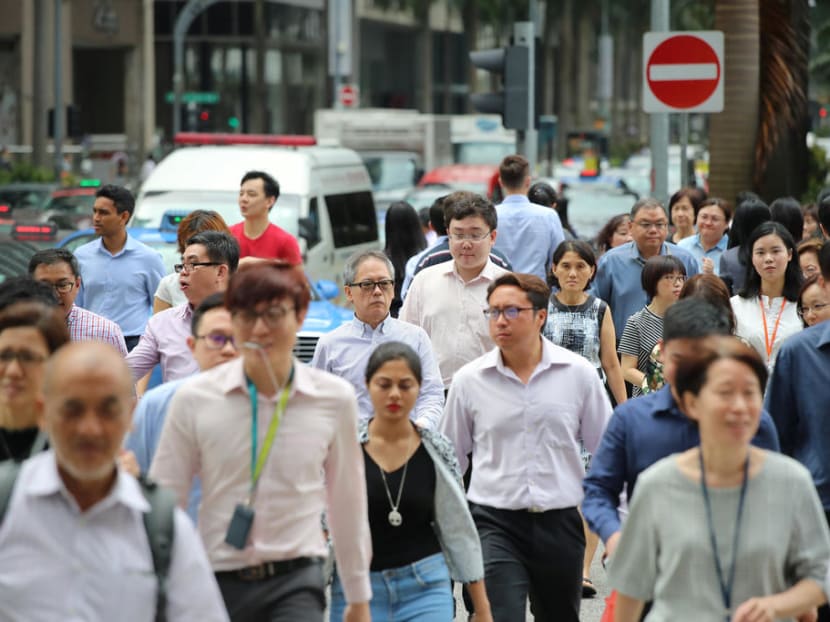Unemployment, retrenchments creep up in second quarter: MOM
SINGAPORE — More workers were retrenched in the second quarter of the year, while the unemployment rate also crept up last month, based on the latest labour figures from the Ministry of Manpower (MOM).

Analysts, economists and recruitment experts cautioned that while having more jobs than unemployed persons is generally positive, the figure points to stresses in the labour market that need to be addressed.
SINGAPORE — More workers were retrenched in the second quarter of the year, while unemployment also crept up last month, the latest labour figures from the Ministry of Manpower (MOM) showed.
Economists told TODAY that though the rise in numbers was small and did not pose a major concern, the threat of a full-blown trade war between the United States and China could place a drag on hiring going ahead.
Releasing preliminary labour market figures for the second quarter of 2018 on Friday (July 27), the MOM said the seasonally adjusted unemployment rate inched up to 2.1 per cent at the end of the second quarter, from 2 per cent at the close of the first quarter.
The jobless rate for citizens and permanent residents registered the largest jump, rising from 2.8 per cent to 3 per cent in the same period. The citizen unemployment rate also rose from 3 per cent to 3.1 per cent.
The MOM said the higher unemployment figures came in the face of more people entering the workforce to seek employment on account of a “continued expansion in economic activities”.
Economist Selena Ling, OCBC Bank’s treasury research and strategy head, added that some workers, such as those who may have left the workforce after trying in vain to land a job, may have returned to the market owing to better job prospects with the economy on the mend in recent months.
While the rising unemployment comes on the back of a general downward trend since last June, unemployment remained lower than a year ago, noted the ministry.
More workers were retrenched between April and June, compared with the first quarter. Preliminary estimates showed that 2,500 workers were retrenched, up from 2,320 workers in the first quarter — though lower than the 3,640 workers made redundant a year ago.
The uptick reflected continuing “restructuring and reorganisation”, the MOM said, cautioning that retrenchments may go up as these trends gather pace.
The manufacturing sector recorded the biggest jump in retrenchments, with 800 workers given the pink slip in the second quarter. This made up nearly a third — or 32 per cent — of the workers made redundant.
Although redundancies declined in services, the sector continued to account for the majority of retrenched workers (52 per cent). Sixteen per cent of redundancies were from the construction industry.
Earlier this week, TODAY reported that hundreds of employees from technology giant IBM Singapore were being laid off amid the company’s global restructuring efforts. The affected workers are from its Singapore Technology Park, a manufacturing plant in Tampines, as the firm is relocating manufacturing of its Power Systems product to a facility in Mexico.
The firm carried out the first two rounds of retrenchment in May and June, with a third round to take place at the end of this month.
The total pool of workers in employment, excluding foreign domestic workers, expanded by 7,100 in the second quarter, markedly higher than the increase seen in the first quarter (400). The services sector continued to pile on workers — 7,800, excluding foreign domestic workers — particularly in sectors such as transportation and storage, information and communications, community, social and personal services, professional services, as well as financial and insurance.
Employment in the construction sector, which has been hit by continued weakness in private-sector activity, shrank by 600, while employment in manufacturing stayed largely flat.
‘NO STRAIGHT-LINE RECOVERY’
While the numbers were not a big concern, economists cautioned that factors such as the escalating US-China trade war and external economic headwinds could affect the labour market.
Mr Song Seng Wun, an economist with CIMB Private Banking, said the latest numbers showed the job market was not experiencing a “straight-line recovery”, despite having turned the corner.
DBS Bank senior economist Irvin Seah said the uptick in unemployment and retrenchments were a sign of “normalisation” in the labour market. He added: “Naturally, the improvements in the labour market at some point will also flatten out.”
Mr Seah said some industries were still struggling to cope with policy shifts – such as tightened foreign worker inflows weighing down on labour-intensive sectors – and the impact of disruptive technologies.
Only certain sectors such as information technology, healthcare and community services are hiring, said Mr Song, and the outlook for others is less optimistic.
Construction-related manufacturing activity, for instance, may be experiencing a slowdown, while a rebound in sectors such as offshore and marine will hinge on order flows, he added.
In the second quarter of this year, Singapore's economic growth slowed and missed forecasts, as manufacturing activity cooled and worsening US-China trade tensions clouded the outlook, preliminary data from the Ministry of Trade and Industry showed earlier this month.
The economy expanded 3.8 per cent from April to June compared with a year earlier, shy of economists' median forecast of a 4 per cent expansion.
Mr Song said the manufacturing sector is undergoing a protracted phase of restructuring which began four years ago. Owing to constraints on labour, companies here have had to engage in high-value-added, specialised forms of manufacturing.
Mr Seah said the retrenchments in the manufacturing sector are the result of processes being automated in a drive to raise productivity, and this “will continue as the economy continues to transform”.
The tit-for-tat trade war between US and China could also weigh down the labour market for the rest of 2018, said experts.
Maybank Kim Eng senior economist Chua Hak Bin said exporters and trade-related sectors, such as ports, electronics, shipping and air cargo, could be hit if the trade tensions escalate into a full-blown trade war.
This could deal a “severe confidence shock” to businesses, forcing them to adopt a cautious stance and pull back on investments and hiring.
But it is not all doom and gloom, as economists cited hospitality, business services, healthcare and information and communications technology as among the sectors likely to be more resilient.
On Friday, the MOM said in a statement that it was “increasingly important” for workers and businesses to stay agile and responsive to emerging technological trends, economic restructuring and the evolving workforce landscape.
Commenting on the latest labour market figures, Mr Patrick Tay, an assistant secretary-general with the National Trades Union Congress, said even though retrenchments for the first half of the year remain low compared with the same period in the last two years, he expects the number to inch up in the third quarter.
That is because Singapore continues to “see pockets of layoffs due to reorganisation, restructuring and re-strategisation amid technological (and) digital disruption, including uncertainties caused by the US trade sanctions”.
Sign up for TODAY's WhatsApp service. Click here:








